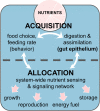The multi-tasking gut epithelium of insects
- PMID: 25982023
- PMCID: PMC4644519
- DOI: 10.1016/j.ibmb.2015.05.004
The multi-tasking gut epithelium of insects
Abstract
The insect gut epithelium plays a vital role in multiple processes, including nutrition, immunity and osmoregulation. Recent research is revealing the molecular and biochemical basis of these functions. For example, the pattern of nutrient acquisition by the gut epithelium is integrated into the overall regulation of nutrient allocation, as illustrated by evidence for systemic controls over expression of key genes coding digestive enzymes and transporters in carbohydrate acquisition; and the abundance and diversity of microorganisms in the gut lumen is regulated by multiple molecular properties of the gut epithelial cells, including the synthesis of enzymes that produce reactive oxygen species and anti-microbial peptides. These traits are underpinned by the function of the gut epithelium as a selective barrier which mediates the controlled movement of water, ions, metabolites and macromolecules between the gut lumen and insect tissues. Breakdown of the gut epithelial barrier has been implicated in muscle paralysis of insects at low temperatures (chill coma) and in aging. The key challenge for future research is to understand how the multiple functions of the insect gut epithelium are integrated by signaling interactions among epithelial cells, the gut microbiota and other insect organs.
Keywords: Epithelium; Gut; Immunity; Microbiota; Nutrient assimilation; Stem cell.
Copyright © 2015 Elsevier Ltd. All rights reserved.
Figures



Similar articles
-
Insect anal droplets contain diverse proteins related to gut homeostasis.BMC Genomics. 2018 Oct 30;19(1):784. doi: 10.1186/s12864-018-5182-z. BMC Genomics. 2018. PMID: 30376807 Free PMC article.
-
Better living through microbial action: the benefits of the mammalian gastrointestinal microbiota on the host.Environ Microbiol. 2009 Sep;11(9):2194-206. doi: 10.1111/j.1462-2920.2009.01941.x. Environ Microbiol. 2009. PMID: 19737302 Review.
-
Alterations of gut barrier and gut microbiota in food restriction, food deprivation and protein-energy wasting.Clin Nutr. 2015 Jun;34(3):341-9. doi: 10.1016/j.clnu.2014.10.003. Epub 2014 Oct 12. Clin Nutr. 2015. PMID: 25459400 Review.
-
Towards an integrated understanding of gut microbiota using insects as model systems.J Insect Physiol. 2014 Oct;69:12-8. doi: 10.1016/j.jinsphys.2014.05.016. Epub 2014 May 24. J Insect Physiol. 2014. PMID: 24862156 Review.
-
[MicroRNA regulation on host-microbiota interaction--a review].Wei Sheng Wu Xue Bao. 2013 Oct 4;53(10):1018-24. Wei Sheng Wu Xue Bao. 2013. PMID: 24409756 Review. Chinese.
Cited by
-
Transcriptional Analysis of The Adaptive Digestive System of The Migratory Locust in Response to Plant Defensive Protease Inhibitors.Sci Rep. 2016 Sep 1;6:32460. doi: 10.1038/srep32460. Sci Rep. 2016. PMID: 27581362 Free PMC article.
-
Novel Insights into the circRNA-Modulated Developmental Mechanism of Western Honey Bee Larval Guts.Insects. 2023 Nov 20;14(11):897. doi: 10.3390/insects14110897. Insects. 2023. PMID: 37999096 Free PMC article.
-
A comprehensive cell atlas of fall armyworm (Spodoptera frugiperda) larval gut and fat body via snRNA-Seq.Sci Data. 2025 Feb 12;12(1):250. doi: 10.1038/s41597-025-04520-z. Sci Data. 2025. PMID: 39939604 Free PMC article.
-
Rapid and Selective Absorption of Plant Defense Compounds From the Gut of a Sequestering Insect.Front Physiol. 2022 Mar 3;13:846732. doi: 10.3389/fphys.2022.846732. eCollection 2022. Front Physiol. 2022. PMID: 35309070 Free PMC article.
-
Insights into midgut cell types and their crucial role in antiviral immunity in the lepidopteran model Bombyx mori.Front Immunol. 2024 Feb 14;15:1349428. doi: 10.3389/fimmu.2024.1349428. eCollection 2024. Front Immunol. 2024. PMID: 38420120 Free PMC article. Review.
References
-
- Andersen JL, Manenti T, Sorensen JG, MacMillan HA, Loeschcke V, Overgaard J. How to assess Drosophila cold tolerance: chill coma temperature and lower lethal temperature are the best predictors of cold distribution limits. Funct. Ecol. 2015;29:55–65.
-
- Ashford DA, Smith WA, Douglas AE. Living on a high sugar diet: the fate of sucrose ingested by a phloem-feeding insect, the pea aphid Acyrthosiphon pisum. J. Insect Physiol. 2000;46:335–341. - PubMed
-
- Billingsley PF, Lehane MJ. Structure and ultrastructure of the insect midgut. In: Lehane MJ, Billingsley PF, editors. Biology of the Insect Midgut. Chapman and Hall; London, UK: 1996. pp. 3–30.
Publication types
MeSH terms
Substances
Grants and funding
LinkOut - more resources
Full Text Sources
Other Literature Sources

